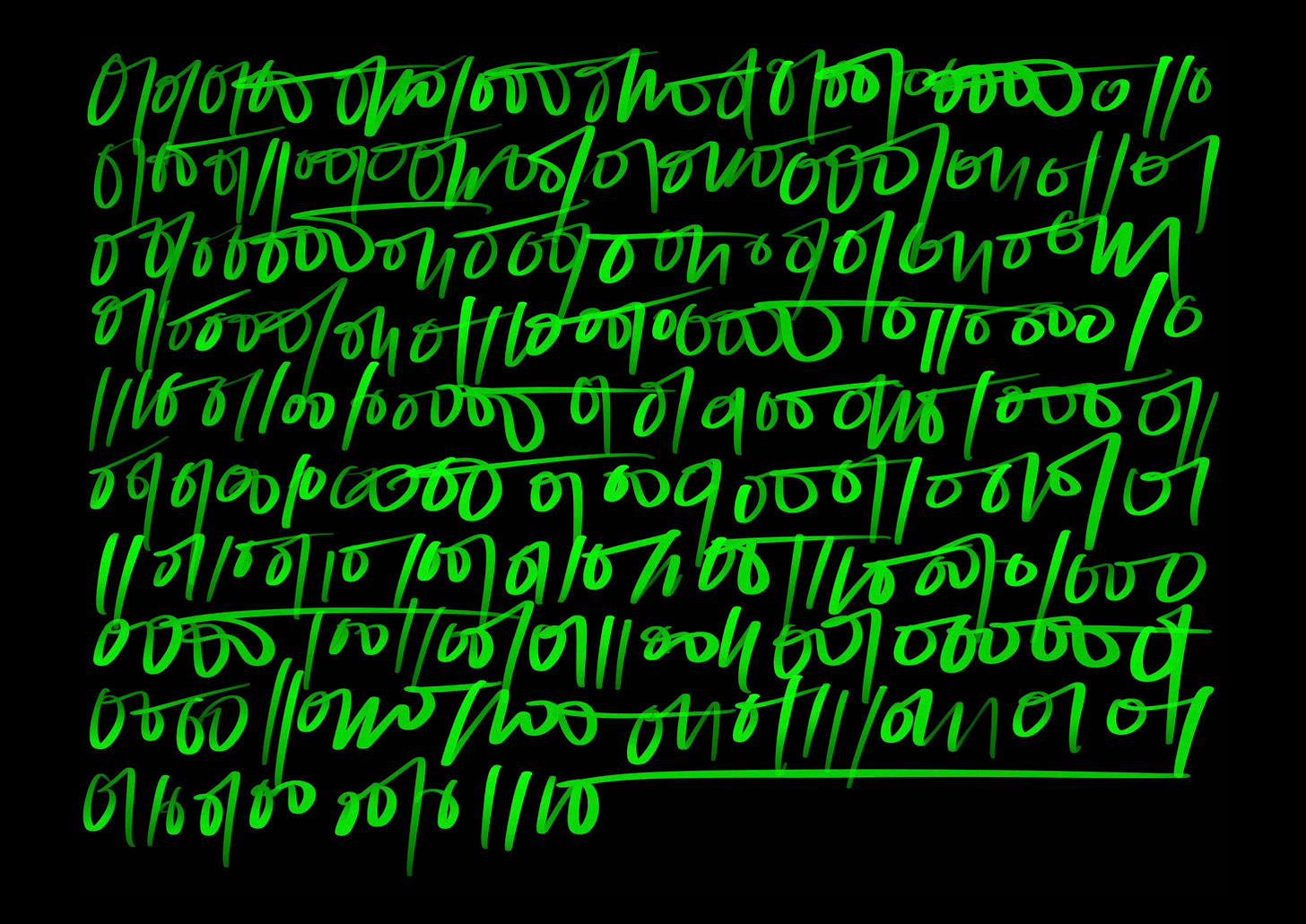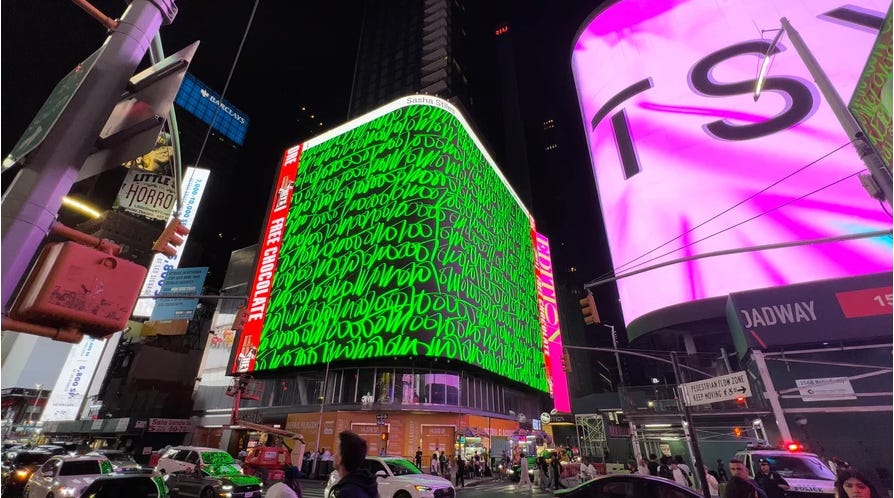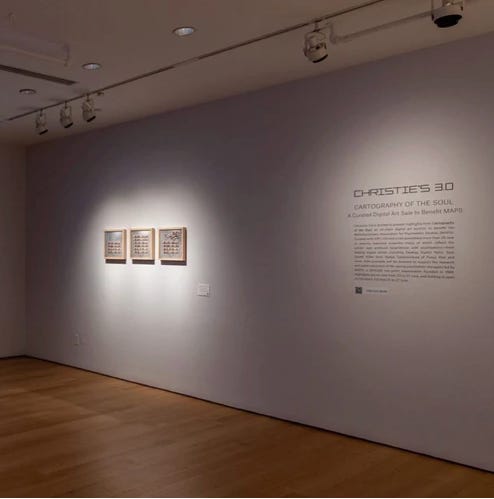Interview with AI artist and poet Sasha Stiles
A first of its kind for AI Futures
I’m thrilled to introduce a new series on AI Futures for Art + Design, in which I will be presenting interviews with artists working in the AI space.
I couldn’t be happier to feature superstar artist and writer Sasha Stiles as our inaugural subject.
Sasha Stiles is an award-winning poet, artist, and AI-researcher working with Artificial Intelligence. She is the author of Technelegy (Black Spring Press Group, 2021), and has been named “perhaps the leading blockchain poet” by Right Click Save, as well as one of the top 10 NFT artists to watch in 2023. She has exhibited at many leading galleries and institutions including Superchief Gallery NYC, SuperRare Gallery, Kunsthalle Zurich, Annka Kultys Gallery, Unit London, Art Cologne, the Museum of Contemporary Digital Art, and L’Avant Galerie Vossen and has been honored by the Lumen Prize, Pushcart Prize, Christie’s, Art Basel, Cool Hunting, Art Forum, and the Washington Post, among others.
Kate Armstrong: Will you introduce yourself in your own words?
Sasha Stiles: I’m a lifelong poet and language artist fascinated by the intersection of text and technology. I tend to think of language as a technology, and poetry as a kind of data storage system for essential ideas and information. While my background is on the more traditional side of the writing world, I experiment with a range of tools, from generative code and digital animation software to AI-powered natural language processing, as well as analog materials.
Digital textblock based on generative text co-authored by Sasha Stiles and her AI alter ego, Technelegy. 2023.
KA: What was your path into working with AI tools like large language models?
SS: I’m consumed by the question of how our fast-advancing technologies are changing what it means to be human – how the rise of things like social media and the science of life extension have implications for the fundamentals of the human condition that we modern creatures typically take for granted and think of as immutable. It’s technologies like the hand axe and oral language and fire and clay tablets that have enabled us to become more and more human with time; we’re already transhuman in profound ways, even though we don’t often regard ourselves that way. These ideas have dominated my curiosity and my research for a long, long time, and that research brought me to a realization that “artificial intelligence” – and specifically, language models trained on vast quantities of human writing and powered by AI – has deep roots in the long history of linguistic innovations that have shaped consciousness and imagination. More tangibly, as someone who loves nothing more than playing with words, the first time I used an off-the-shelf AI text generator I was flooded with inspiration. It was exhilarating to have that first taste of an entirely new way of writing, of bringing language into being, and I was hooked.
Cursive Binary : Fragment 2, 2021
MP4, (colour, no sound), 1 min, dimensions variable
Edition of 100
Courtesy of the artist and Annka Kultys gallery
KA: In your book Technelegy you worked with GPT-2 and GPT-3 (earlier versions of ChatGPT) by training them on your own poetry. Your work takes many forms, including NFTs, digital animation, projection, installation, prints, and photographs of coded poems composed of natural objects like walnuts. Could you elaborate on how you approach form and how it relates to themes in your work, which appear to be engaged with the impact of emerging technologies on human experience?
SS: I’ve been reading and writing poetry for as long as I can remember, and for an equally long time I’ve been obsessed with the shape and form of language, the art of language, and how aesthetic elements like color, font, size, material, etc., influence how a text makes me feel. I adore text-based art by Agnes Denes, Alison Knowles, Jenny Holzer, Bruce Nauman, Ed Ruscha, Glenn Ligon, Nora Turato, Douglas Coupland, Ackroyd & Harvey, and so many others. As a child, I spent hours hand-making paper and books, crafting my own stationery, designing my own amateur fonts; later, even as I was submitting my writing to literary journals in the mandatory Times New Roman, 12-point format, I was always exploring multidimensional ways for my poetry to take shape. I tend to think of my digital, media-rich poetry as a kind of variation on spoken word – the text itself is a libretto, and there are myriad ways it can be performed in order to explore different facets of the poem and offer different reading experiences (for example, as projection mapping, immersive video booths, eco-art sculpture, animated digital broadside, long-form generative NFT series, and so on). As technology is propelling us into high-dimensional space, why as writers should we confine ourselves to the conventional formats, paperback or hardcover or zine, to the boundaries of a variation of a printed page? I think writing in multiple dimensions may be a way of touching as-yet-unnamed emotions, as-yet-unidentified senses – articulating things we don’t yet know how to say.
Courtesy Artcrush gallery world tour, 2023.
KA: As we step into a new cultural era, art is being shaped and accelerated by AI and Machine Learning (ML) technologies. Beyond our current fascination and amazement with the rapid release of AI-driven tools for public use, I think we should also focus on how these technologies can foster entirely new experiences, environments, and artworks. In the grand scheme of things, could you share your thoughts or predictions on potential futures for artists, collectors, and audiences?
SS: I’m always being asked if I think AI is or could soon become conscious; but what really titillates me is how AI is already extending our own human consciousness. AI to me is augmented or amalgamated imagination, a way of strapping on a prosthetic body of knowledge and exploring it at a speed and scale our analog minds are simply not equipped to do on their own. A truism among authors is to “write what you know.” AI dramatically expands what we know, floods our language with nuances and allusions and references that we don’t even know we know, and I think that has really fascinating implications for the way we typically think of authorship and creativity, as primarily solo or solitary endeavors. There’s a lot of focus on collaboration between human and machine, but there’s also a great deal in store when it comes to the way AI, as well as related technologies like blockchain, can facilitate collaboration between many humans. For example, at theVERSEverse we’re using a custom text generator trained on the writing of every human poet in the collective to produce poems written in the voice of the entire collective – an experiment to see what kinds of motifs, themes, vocabularies, poetic devices are revealed via machine refraction, this next-gen line reading and analysis. Generally speaking, the fact that many AI models are built on text as data and use text-to-image interfaces is also putting language in a new light for many people, both in terms of how people are using these tools and the way that many writers, literary scholars, poets, etc., are being tasked with training these models. Language is something we often take for granted, and I think AI is forcing us to recalibrate its value as well as the value of those who have a mastery of language.
Analog Binary Code at Cartography of the Soul, Christie's
KA: You are known for exploring the creative possibilities that open up when poetry is put on chain, how NFTs can expand the way poetry is monetized, how it circulates outside of traditional platforms, and how it can catalyze connection and exchange. For people who aren’t familiar with the current state of the NFT scene - in blockchain poetry but also art - could you describe what you see happening? What are the characteristics of these communities, how are these new technologies shaping the work that is produced, and what are some differences you see between the culture of what is happening now and what has happened historically in past artistic frameworks or eras?
SS: I came to the blockchain organically, because it was a way to publish the media-rich poetry I couldn’t publish via other channels. Not only has web3 enabled me to explore new ways forward in terms of “printing” and distribution, but it’s cracked open new possibilities for form and genre and expression, and that’s also true for the many intrepid writers I know who’ve explored NFTs. Poets and writers reflect life as we know it, and to me that involves both continuing to champion physical, analog book objects and plain text formats while also exploring how technology can empower me to use motion, time, color, animation effects, sound and other digital vernaculars as part of my poetic voice. To me, that’s a big difference between what’s happening here and in historical contexts – the avant-garde adventures we’re undertaking on the blockchain are an explicit response to our new, unprecedented experience of digital dualism, of existing simultaneously online and offline, as avatars and flesh-and-blood beings. (Of course, even this experience has its own referents in mind-body dualism and the ways in which language functions as a kind of augmented reality…)
Analog Binary Code by Sasha Stiles – Image Courtesy of Sasha Stiles
KA: Who are some of the artists working with AI whose work interests you at the moment?
SS: Stephanie Dinkins’ “Conversations with BINA48” is a touchstone for me, and her experiments with family memoir via AI have been on my mind a lot lately. Sougwen Chung’s robot-assisted mark-making is gorgeous and evocative. I’ve treasured my conversations with AI language pioneers including Ross Goodwin and K. Allado-McDowell. Allison Parrish’s book Wendit Tnce Inf is a thing of uncanny beauty. I continue to return again and again to Mark Amerika’s book, My Life as An Artificial Creative Intelligence (which, full disclosure, I reviewed last year for Outland Magazine), and continually revisit David Jhave Johnston’s ReRites. Perhaps above all, I’m delighted to no end by Mario Klingemann’s pet art critic, A.I.C.C.A. (Artificially Intelligent Critical Canine).
KA: You also work as a curator on exhibitions and projects through theVERSEverse, which has been described as a “crypto literary collective where poems are art, poetry is code, and language is limitless”. Could you tell us more about theVERSEverse and some of the projects that are forthcoming?
SS: theVERSEverse is a literary gallery and writer’s collective that aims to be a hub for poets in the metaverse and beyond. We often say that we believe poems are works of art, but to my mind we are equally dedicated to celebrating how poetry does things that no other kind of art can do. We platform language artists who are already working across mediums and exploring crypto-native writing tools, but we also pair “traditional” poets with artists as well as creative technologists and coders and engineers to push the limits of language and explore meaningful ways to write, read and publish in our digital age. We’re invested in the invention of new possibilities for literature, and are fortunate to partner with many innovative arts and tech institutions. Right now, our focus is on an exciting research project with The Allen Ginsberg Estate, experimenting with how an AI-empowered text corpus can invigorate scholarship and inspire new generations of writers, readers, and academics.
KA: What does the life of an artist/writer/designer look like in 2033?
SS: In 2019, I published these lines, and I think they still hold up:
“In ten more years we’ll know how to implant IQ, insert whole languages. I’ll be a superpoet, then, microchipped to turbo-read neural odes, history of sonnets and aubades brainlaced, wisdom wended through the jugular, inspiration ad infinitum. We’ll print solely on ether, cloud vellum indelible, every word a relic of sentient reverence pressed with angel ink, medium of our new nature.”
Thank you so much Sasha for talking to me and sharing your incredible work and fascinating perspectives. Can’t wait to see what you get up to next !!







Sasha continues to inspire. She’s a trailblazer I look up to in my own artistic practice.
Sasha is one of the greats. I love the interview she gave on Rattlecast 203 (on youtube).